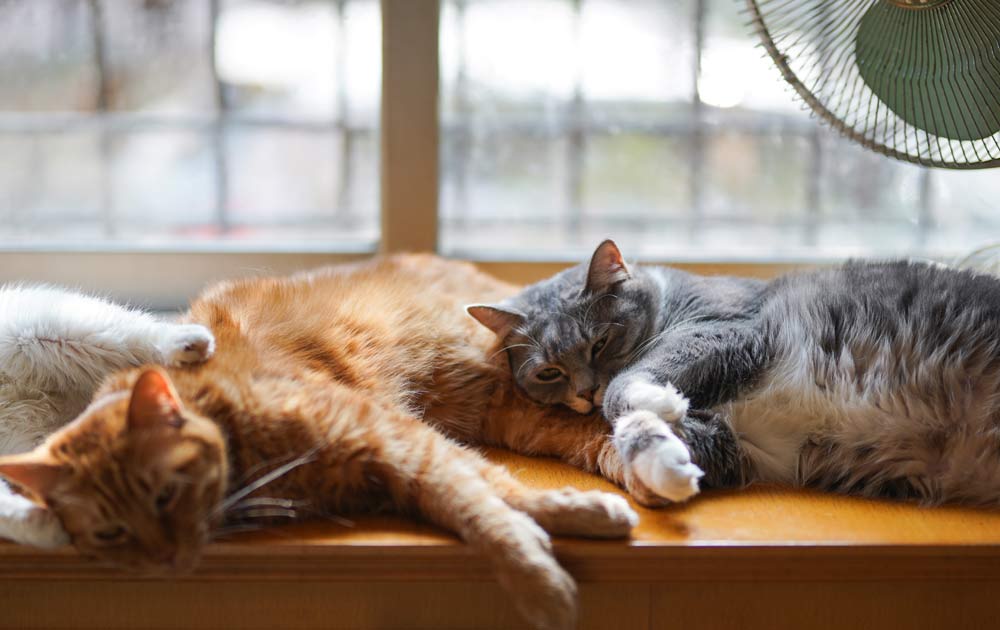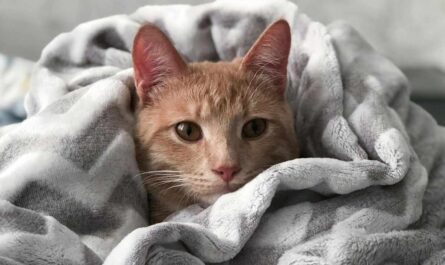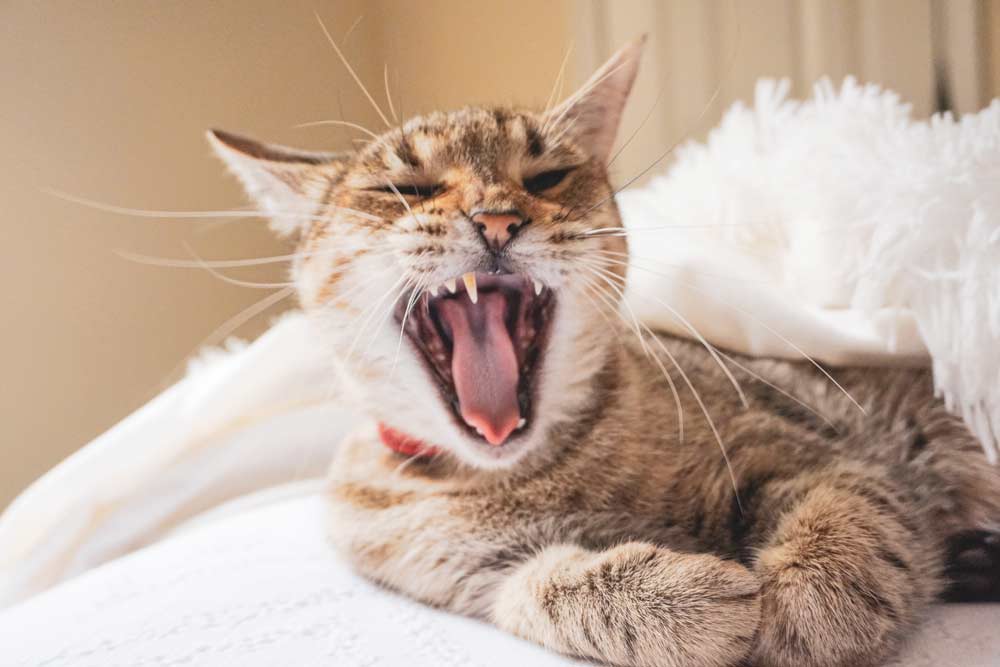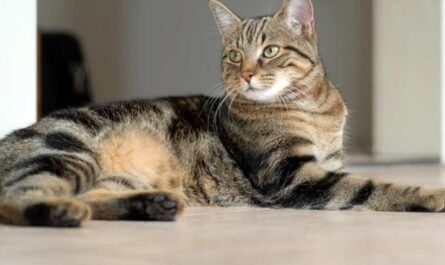The hissing sound of a cat, though often misunderstood as a straightforward signal of aggression, Cats Hiss is a melange of emotions woven into the fabric of feline communication. It serves as a symphony of warning, an audible expression of a cat’s intricate psyche. Unraveling the mysteries of cat hissing entails delving into the realm of their emotions, and deciphering the nuanced signals they convey. As cat owners embark on this journey, armed with knowledge and empathy, they can transform the hiss from a perplexing enigma into a guide for fostering understanding and harmony with their feline companions.
The Enigma of Cat Hissing: Deciphering Feline Vocalizations
Do you ever find yourself pondering the peculiarities of feline behavior, particularly the enigmatic act of hissing? It’s a sound as distinct as the low growl of a protective dog or the ominous buzz of a rattlesnake’s tail. When a cat hisses, the universe seems to pause, and our human curiosity kicks in. Most people instinctively interpret a cat’s hiss as an unmistakable signal of anger or aggression. Yet, is it possible that this vocalization conceals a deeper, more nuanced feline language?
Unlocking the Code: Decoding the Feline Hiss
Hissing, far from being a mere manifestation of feline fury, is a complex facet of normal cat behavior. Contrary to popular belief, it does not always serve as an overt sign of aggression. Cats, being intricate creatures with a rich tapestry of expressions, utilize hissing as a tool for communication. It is their primal language, a warning sign etched in sound waves, alerting someone or something that they perceive as a potential threat. The feline hiss, therefore, becomes an enigmatic symphony of feline emotions, encompassing not just anger but a spectrum of feelings, from fear to frustration.
Harmony Amidst Hisses: Nurturing a Cat-Friendly Environment
For cat owners caught in the perplexing web of feline hissing, there exists a roadmap to harmony. It is imperative to recognize that a hissing cat is not a hostile one, but rather a creature attempting to communicate its distress. Creating an environment that mitigates feline anxiety is paramount. By identifying and addressing the triggers that induce hissing, cat owners can establish a sanctuary of calm for their feline companions. Whether it’s introducing gradual socialization, providing secluded spaces, or employing positive reinforcement, the journey toward minimizing a cat’s distress and the accompanying hissing is a nuanced endeavor.
Navigating the Feline Psyche: The Subtleties of Cat Communication
Understanding the motive behind a cat’s hiss requires a foray into the labyrinthine landscape of feline psychology. When a cat hisses, it is akin to a cryptic message that demands decoding. More often than not, it serves as a defensive mechanism, an instinctual response to a perceived danger. Cats, being creatures of habit and territory, resort to hissing to establish boundaries and protect their sanctuary. The hiss, therefore, serve as a multifaceted tool, not merely expressing displeasure but acting as a psychological barrier, dissuading potential threats from encroaching upon their perceived domain.
What Is a Cat Hiss?
Cat hissing, once dismissed as a simple sound, emerges as a nuanced language, a ballet of warning signals. From the orchestrated expulsion of breath to the intricate choreography of body language, each element plays a crucial role in the feline communication repertoire. Understanding the intricacies of cat hissing unveils a silent language, a code of survival etched into the very essence of these enigmatic creatures.
The Intricate Language of Cat Hissing: A Symphony of Warning Signals
A cat’s hiss, a seemingly simple auditory event, unfolds as a complex interplay of physiological mechanisms. It is not merely a random exhalation of air; rather, it is a deliberate expulsion across the cat’s arched tongue, resonating through the contours of the feline mouth. This sudden, explosive release of breath is accompanied by a symphony of visual signals, a ballet of warnings. The feline choreography includes the dramatic baring of teeth, a visual proclamation of threat, and the elegant retraction of lips, creating an ominous tableau of aggression. The ears, once perky, now flatten against the head, a manifestation of the cat’s heightened defensive posture.
A Symphony of Physical Gestures: The Artistry of Cat Communication
Beyond the audible hiss, cats employ a repertoire of physical gestures, transforming a simple warning into a multidimensional display. Picture this: a feline arching its back, a graceful curvature that extends beyond mere aesthetics. This action, a blend of elegance and menace, serves a strategic purpose. Concurrently, the cat’s hair stands erect, a phenomenon known as piloerection, transforming its silhouette into a formidable spectacle. This inflation of fur is not a mere cosmetic alteration; it is a visual illusion, a primal attempt to appear larger than reality, a cunning strategy to dissuade potential predators from approaching.
The Strategic Illusion: Cat’s Morphing Size and the Art of Dissuasion
Behind the curtain of feline theatrics lies a strategic illusion, an artful manipulation of perception. The arching back and the puffed-up coat are not mere theatrics; they are calculated maneuvers to alter the cat’s apparent size. In the intricate dance of survival, the feline instinctively understands that a larger silhouette is a deterrent to potential threats. It is an evolutionary adaptation woven into the fabric of feline behavior—a survival tactic honed over generations.
The Theatrics of Fear: Growls, Spits, and Forceful Hisses
In the crescendo of feline expression, when the cat is truly distressed, the auditory landscape evolves. Growls resonate like distant thunder, a low rumble of discontent. Spitting, a visceral expulsion of saliva, accompanies the hiss with such force that it becomes a weapon of intimidation. Picture a cat, fur bristling, teeth exposed, and a forceful hiss that propels saliva into the air—an overt manifestation of displeasure. It is not just a hiss; it is a declaration, a primal scream translated into the feline vernacular, a final warning to any intruders.
When a Cat Is Hissing at People
When a cat finds itself perched on the unfamiliar coldness of a veterinary exam table, the natural response is often a symphony of hissing. The veterinary clinic, laden with peculiar sights, sounds, and smells, becomes a haunting reminder of past frightening encounters. The feline’s memory intricately weaves together the trauma, resulting in preemptive hisses at the mere arrival, before any probing or prodding has taken place.
Moreover, felines, creatures of habitual comfort, manifest their trepidation in unfamiliar environments. Be it the boarding facility or the grooming salon, the unaccustomed sights and scents trigger an instinctual fear response, a crescendo of hissing to convey their unease. Even in the domestic realm, the intrusion of new faces, be it guests or workers, may provoke a feline symphony of hisses, an auditory defense mechanism against the unknown, further exacerbated when loud, unfamiliar children join the scene.
Attempting to engage a cat in activities outside its realm of comfort—be it bathing, brushing, or administering medication—often invites a chorus of hisses. These actions, perceived as stress-inducing, evoke a visceral response, the hiss serving as a vocalization of the feline’s discomfort. Intriguingly, a cat may also hiss when held or petted by someone who fails to elicit a sense of ease, signaling that the feline is grappling with an internal discomfort or potential pain, urging the offending party to maintain a respectful distance.
When Cats are Hissing at Each Other
In the intricate tapestry of multi-cat households, the feline hiss emerges as a communicative tool during clashes and disputes. The communal litter box or the communal feeding area can transform into battlegrounds, resonating with hisses as felines assert dominance or vie for territorial supremacy. The formation of alliances, where multiple cats may unite against a singular feline, manifests in stalking and ambushing scenarios, unleashing a crescendo of hisses.
Introducing a new member into the feline fold is a delicate symphony, marked by the dissonant notes of hissing. The established residents hiss in caution and uncertainty, delineating boundaries and asserting their position within the social hierarchy. Yet, in the gradual orchestration of scent-sharing and presence-acceptance, the hisses wane, giving way to a newfound harmony. The hiss, in this context, is not a perpetual discord but a transitory expression of feline social dynamics, evolving into a tranquil melody as familiarity blossoms.
Common Reasons Why Cats Hiss
In your quest to unravel the feline enigma, your trusted veterinarian is your initial guide. They are the gatekeepers to the realm of feline health and behavior. If the journey becomes more intricate, if the hisses persist as cryptic whispers in the dark, the path leads to the doorstep of a veterinary behaviorist. Together, they form a dynamic duo, dedicated to deciphering the complex language of feline emotions, making your cat’s mysterious hisses not just a puzzle but a story waiting to be unveiled.
1. Fear and Anxiety
Hissing becomes a vocal manifestation of feline anxiety and fear, akin to a verbal defensive posture. When confronted with a situation that elicits trepidation, such as encountering a new person or animal, a cat may resort to hissing as a preemptive measure. This audible display of unease serves as a deterrent, a way to communicate discomfort, signaling the need for space and a temporary retreat from the unsettling circumstance. It’s a linguistic plea for peace, a plea that echoes through the feline vocal repertoire.
2. Territorial Instincts
Cats, those enigmatic feline companions, often hiss as a primal response deeply rooted in their territorial instincts. This behavior emerges when a cat perceives an intrusion into its perceived domain, be it the living room or the backyard. The hiss, a sonorous expulsion of breath, serves as a vocal warning, a line drawn in the sand. It’s a manifestation of their innate need to establish and maintain boundaries, showcasing the evolutionary remnants of their wild ancestors who fiercely guarded their territories.
3. Social Hierarchy
In the intricate tapestry of feline social dynamics, hissing plays a pivotal role in establishing and maintaining hierarchies. Cats, being inherently solitary creatures, engage in hierarchical struggles, especially in multi-cat households. Hissing becomes a vocal chess move, a strategic maneuver to assert dominance or, conversely, to express submission. This nuanced vocalization mirrors the complex web of relationships that define a cat’s social sphere, a language of status and submission spoken through the guttural tones of a hiss.
4. Protective Maternal Instincts
Mother cats, fiercely protective of their offspring, often exhibit hissing behavior as a shield against perceived threats. This instinctual response aims to create a barrier between potential harm and vulnerable kittens. The hiss, laden with maternal concern, is a formidable deterrent, signaling to intruders that encroaching upon the feline nursery is not only unwelcome but met with a vocal resistance that echoes the lioness’s roar in the vast savannah.
5. Illusionary Aggression
Hissing, in some instances, might not be a genuine expression of aggression but rather a calculated feint—an illusion of hostility. Cats, masters of bluffing, may hiss to create a façade of ferocity, a vocal smokescreen concealing their true intentions. This tactic is often employed in conflicts over resources or territory, a psychological chess game where the hiss serves as a strategic move in the intricate dance of feline negotiation.
6. Pain and Discomfort
A cat in physical distress may unleash a hiss as a vocal expression of pain or discomfort. This could be a response to an injury, an underlying health issue, or even the discomfort of being touched in a sensitive area. The hiss, in this context, becomes a desperate cry for help from a commander, a plaintive wail woven into the fabric of feline communication. Deciphering the hiss in such instances becomes a crucial skill for cat owners, as it serves as a diagnostic clue to potential health concerns requiring prompt attention.
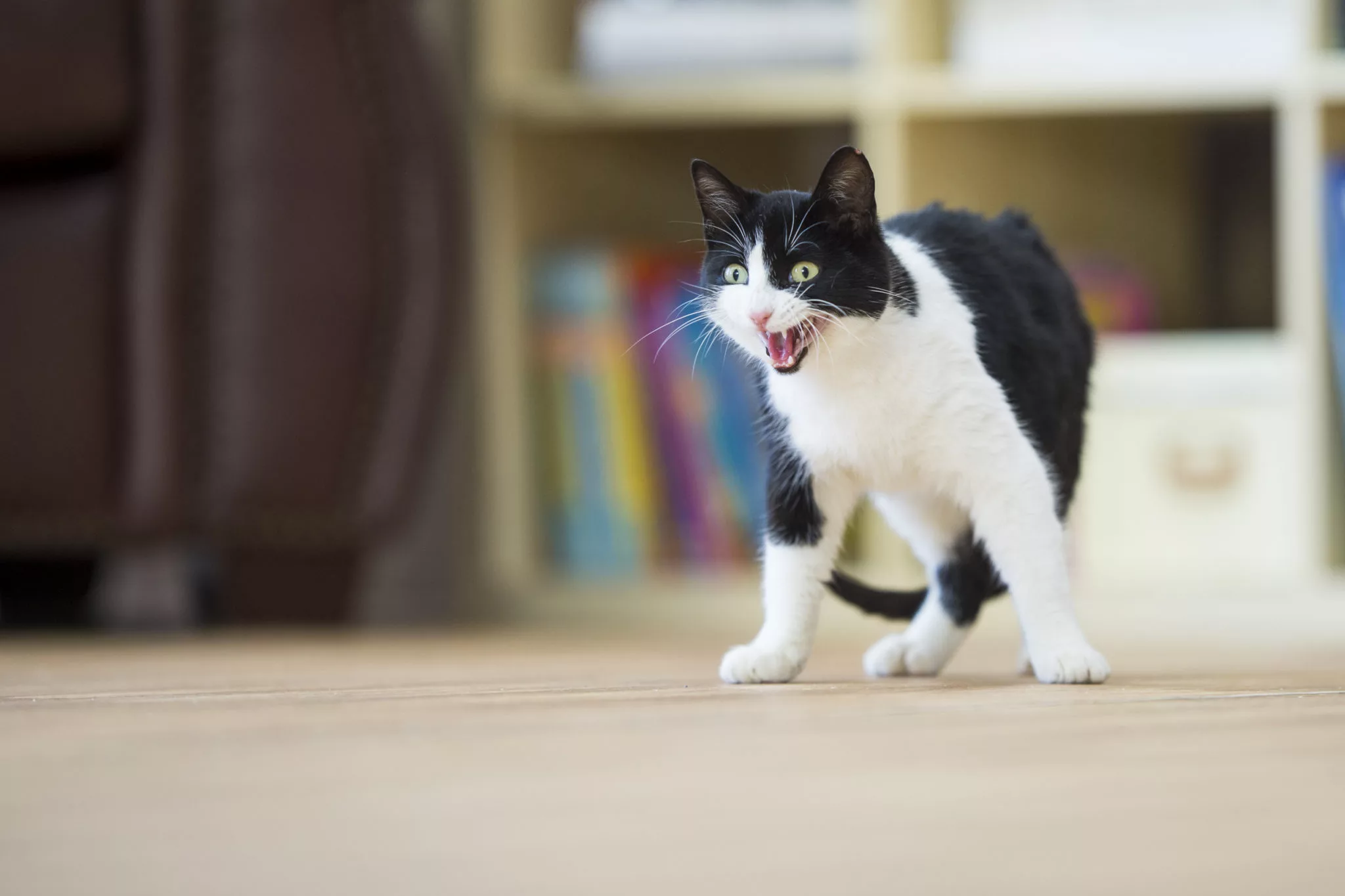
7. Unwanted Handling
Cats are renowned for their independent nature and selective preferences for physical contact. Attempting to handle a cat against its will can trigger a hissing response. Whether it’s an unwelcome attempt at picking up the cat or an intrusive attempt to groom it, the hiss is a vocal barricade erected by the cat. It’s a resounding declaration of personal boundaries, a protest against perceived infringement upon their autonomy. Understanding and respecting a cat’s physical autonomy is key to minimizing hissing in response to handling.
8. Behavioral Challenges
Lastly, hissing can be a manifestation of broader behavioral challenges, including stress, frustration, or a lack of mental stimulation. Cats, with their intricate emotional landscapes, may resort to hissing when faced with circumstances that disrupt their emotional equilibrium. Identifying and addressing the root causes of behavioral challenges is essential in fostering a harmonious environment where hissing becomes a rare and temporary expression, rather than a persistent refrain in the feline symphony of communication.
9. Frightening Sounds and Sudden Movements
The feline senses, finely tuned to detect subtle changes in their environment, can be easily overwhelmed by sudden loud noises or rapid movements. In such instances, a startled cat might resort to hissing as a reflexive response to the perceived threat. The hiss serves as a self-defense mechanism, an attempt to ward off potential dangers and revert to a state of vigilant caution. Owners must be attuned to their cat’s surroundings, ensuring a harmonious environment that minimizes startling stimuli.
10. Health Issues and Painful Memories
Chronic health issues or past traumatic experiences can be etched into a cat’s memory, leaving an indelible mark on their behavior. Hissing, in these cases, maybe a residual response to painful memories or an attempt to communicate lingering discomfort. Understanding the cat’s history and addressing any unresolved health issues is crucial in decoding and mitigating hissing behavior rooted in past traumas.
Do cats ever hiss playfully?
Within the lexicon of feline communication, hissing remains an unequivocal decree, a stark warning signaling a need for reprieve. The notion of playful hissing, contrary to its canine counterpart, remains an anomaly. If a cat hisses amid a play session, it’s a crucial cue demanding respect. Ignoring this semaphore may swiftly transmute the playful dalliance into an encounter less pleasant. In the choreography of feline play, heed the hiss as an unequivocal boundary, ensuring the harmony of play remains a symphony rather than a discordant cacophony.
What To Do if Your Cat Is Hissing and How To Get Them To Stop
Hissing or growling from a cat may initially seem like an unmistakable sign of anger, but delving into the feline psyche reveals a more nuanced reality. Contrary to common misconceptions, hissing is not necessarily indicative of aggression. Rather, it serves as a vocal manifestation of fear, a feline semaphore broadcasting a clear warning: “Stay away, danger lurks.”
Understanding the Hiss: Unraveling the Cat’s Emotional State
When a cat hisses, it’s not a declaration of war but a proclamation of discomfort. The hiss emanates from a place of vulnerability and unease, revealing a cat’s internal struggle with fear. Ignoring this vocalized plea for distance can escalate the situation, pushing a hissing cat toward more overtly aggressive actions such as scratching or biting. Unraveling the complexity of feline behavior requires a nuanced comprehension of the underlying emotions triggering such responses.
Navigating the Hiss: Tips for Handling a Fearful Feline
Navigating the tumultuous waters of a hissing cat’s emotions demands a strategic approach. Foremost among these strategies is the acknowledgment that a hissing cat needs space. This is not a suggestion but a clear directive—respect the feline’s boundaries. Provide an avenue for the cat to retreat to a secure and serene place, allowing time for its frayed nerves to settle, whether it takes mere minutes or stretches into the hours.
Ensuring that a cat has a designated safe haven is paramount. Whether it’s an elevated cat tree or a secluded room tucked away in the depths of the house, this refuge offers a sanctuary for the cat to regain composure. The importance of this retreat cannot be overstated in facilitating a feline’s emotional recovery.
Dissecting the Hiss: Identifying and Mitigating the Source of Fear
Proactive steps can be taken to decipher the root cause of a cat’s fear, unraveling the intricate layers of their anxiety. Pinpointing the source and mitigating it is crucial. If an external factor—perhaps a friend’s exuberant dog—is triggering the hissing, implement measures to neutralize the perceived threat. A dog on a leash or confined to a crate can create a buffer, allowing the cat to regain a sense of security.
In scenarios where external stimuli, such as construction noise, contribute to the cat’s unease, orchestrating a retreat to a soundproof haven is prudent. Introducing calming elements, like soothing music in the safe space, can serve as a balm, drowning out unsettling sounds and facilitating the feline’s return to equilibrium.
Cat Dynamics: Bridging the Gap in Multi-Cat Households
In multi-cat households, the hiss becomes a complex symphony of interwoven dynamics. Introducing a new feline member requires patience and strategic planning. Providing each cat with a designated safe space becomes pivotal during the initial adjustment period. Weeks may elapse before the cats settle into a harmonious coexistence. This delicate period demands a hands-off approach, allowing the cats to acclimate at their own pace.
The specter of conflict among existing cats necessitates a detective-like approach. Identifying the catalyst for discord—be it territorial disputes or bullying—enables targeted interventions. Expanding resources like litter boxes and food/water dishes, combined with ensuring the harassed cat has a secure retreat, can recalibrate the balance within the feline hierarchy. Intervening when necessary and fostering an environment conducive to peaceful cohabitation underscores the complex but ultimately rewarding task of managing multi-cat dynamics.
What should I do if a cat hisses at me?
When a feline companion unfurls the serrated notes of a hiss, it’s a poignant overture, a visceral communication of distress, fear, or perceived threat. The astute response lies in a measured retreat, a respectful acknowledgment of the feline semaphore signaling discomfort. Back away with a deliberate grace, affording the cat a canvas of space within which to navigate its unease. The tapestry of support extends beyond mere withdrawal – cultivating safe havens, introducing calming pheromones via diffusers like Feliway, and embracing an environment bathed in serenity, all conspire to diffuse the tendrils of feline distress and restore equilibrium. See why thousands of cats love BoxCat
It’s Difficult To Identify Why Your Cat Is Hissing
Cats, those enigmatic creatures that grace our homes with their mysterious presence, often resort to hissing as a form of communication. The reasons behind this behavior are as diverse as the feline personalities themselves. It goes beyond mere vocalization; it’s a complex expression embedded in their instincts.
In the intricate world of cat communication, hissing becomes a symphony of warning and self-defense. When your feline companion emits a hiss, it might be engaged in a primal act of safeguarding its territory. This territorial instinct is particularly heightened when they feel their offspring are under threat. Picture a mother cat, her eyes narrowed in protective resolve, emitting a hiss to ward off potential threats to her vulnerable litter. It’s a language rooted in survival, a signal that transcends the boundaries of domesticity.
However, the labyrinth of feline emotions doesn’t end there. Hissing can also be a poignant indication of underlying stress or discomfort. Imagine your cat, hidden in the shadows, arched back, fur standing on end, and a low, menacing hiss escaping its delicate feline lips. This might not merely be a reaction to an external threat; it could be a silent cry for help. Cats, masters of stoicism, often mask physical pain with a cloak of aloofness. The hiss, in such instances, serves as a desperate plea, a non-verbal SOS signaling that something within their delicate physiology is amiss.
If you find yourself bewildered by the symphony of hissing from your feline companion, a pilgrimage to the veterinarian becomes imperative. The veterinarian, armed with medical expertise, is the detective unraveling the mystery of your cat’s discontent. A comprehensive physical examination may reveal ailments or discomfort that elude the untrained eye. The vet becomes a translator, decoding the cryptic language of feline distress, whether it be a dental issue, an injury, or an underlying health concern.
Yet, the complexity deepens when the vet’s scrutiny yields no tangible physical cause for the hissing. This is where the plot thickens, and the narrative takes an intriguing turn. In such cases, the veterinarian, much like a wise sage, might guide you toward a specialist – a veterinary behaviorist. These individuals are the Sherlock Holmes of the feline world, delving into the intricate layers of cat behavior, deciphering the subtle nuances that escape the untrained observer. Cat accessories on Amazon
Should the enigma persist, the veterinary behaviorist becomes your beacon of enlightenment. They navigate the labyrinth of feline psychology, untangling the web of emotions that manifest in hisses and growls. These professionals, armed not only with scientific knowledge but also a profound understanding of feline idiosyncrasies, can provide insights into the triggers causing your cat’s distress. It’s a journey into the realm of emotions, where the feline psyche unfurls like an ancient scroll, revealing tales of fear, anxiety, or even past traumas.
Should I allow my cat to hiss?
In the lexicon of feline expression, hissing emerges as a primal ballet, a healthy manifestation of a cat’s innate repertoire. It stands as a sentinel, a vocalized boundary communicated when a cat feels distressed and yearns for a semblance of distance. Rebuking or punishing a cat for hissing is a futile endeavor, akin to silencing a language designed to convey discomfort. Instead, honor the hiss as a natural dialogue, a communication of boundaries and emotional terrain. If the hissing becomes a relentless refrain, veering towards excess, a prudent course of action involves seeking counsel from a veterinarian to rule out underlying health vicissitudes.
Other Interesting Articles
- Ocicat Cat Breed Profile: Health, Facts, Traits, Groom, Care
- Ojos Azules Cat Breed Profile: Health, Traits, Groom, Care
- Oregon Rex Cat Breed Profile: Health, Traits, Groom, Care
- Oriental Bicolor Breed Profile: Health, Traits, Groom, Care
- Oriental Longhair Breed Profile: Health, Traits, Groom, Care
- Oriental Shorthair Breed Profile: Health, Traits, Groom, Care
- Peterbald Cat Breed Profile: Health, Traits, Groom, Care
- Pixie-Bob Cat Breed Profile: Health, Traits, Groom, Care
- Ragamuffin Cat Breed: Health, Facts, Traits, Groom, Care
- Russian White Cat Breed Profile: Health, Traits, Groom, Care
- Serengeti Cat Breed Profile: Health, Traits, Groom, Care
- Savannah Cat Breed Profile: Health, Traits, Groom, Care
- Selkirk Rex Cat Breed Profile: Health, Traits, Groom, Care
- Singapura Cat Breed Profile: Facts, Coat, Traits, Groom, Care
- Sokoke Cat Profile, Traits, Health, Facts, Grooming, Care
- Somali Cat Profile, Traits, Health, Facts, Grooming, Care
- Turkish Angora Cat Profile, Traits, Health, Grooming, Care
- Sphynx Cat Breed: Profile, Traits, Health, Grooming, Care
- Turkish Van Cat Breed: Profile, Traits, Grooming, Care
- Toyger Cat Breed: Profile, Traits, Health, Grooming, Care
